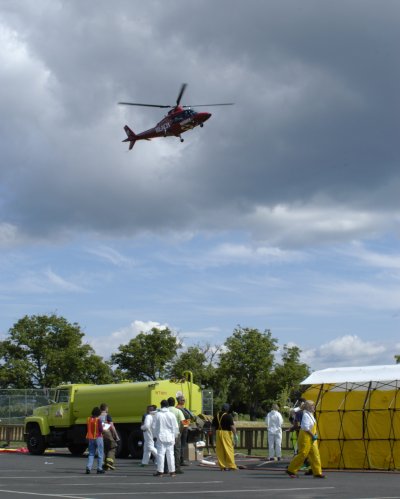
UPPER LAKE – It's a horrifying scenario: At the finish line of a triathlon event where hundreds of spectators are gathered, a multi-vehicle auto collision takes place. There are dozens of injuries, numerous deaths and utter pandemonium. {sidebar id=78}
That was the carefully choreographed disaster situation played out at Upper Lake County Park on Wednesday afternoon. The object was to give local and state agencies an opportunity to evaluate how they work together in emergency situations.
The Lake County Office of Emergency Services conducted the mass casualty incident in cooperation with numerous other agencies, among them Northshore Fire, Lake County Fire and Kelseyville Fire Protection districts; California Highway Patrol; Lake County Sheriff's Office; Cal Fire; the state Office of Emergency Services. Caltrans officials also were on scene to help control traffic past the park, which was a concern, with some drivers stopping to take a look at the action.
Before the exercise started at 3 p.m., volunteers – decked out in fake blood, make up to create wounds such as compound fractures and, in some cases, prosthetics illustrating severely injured limbs – went over their parts in the drama. Moaning, groaning and other realistic touches were encouraged.
California Highway Patrol Officer Adam Garcia said that the scenario included 18 simulated fatalities, 40 major traumas, 25 delayed traumas (meaning major injuries that are not life-threatening) and 25 walking wounded, all of which were attended to by emergency personnel.
Agency incident commanders were Northshore Battalion Chief Pat Brown, Chief Deputy James Bauman of the Lake County Sheriff's Office and CHP Sgt. Dave Stark.
During the first 30 minutes, Brown was furiously directing first responders, adjusting directions and writing plans on a white board on the side of his Northshore Fire vehicle.
He said after the drill that his scribe – a note taker assigned to keep track of his instructions – came away with four pages of handwritten notes.
Those notes, and the event itself, will help Brown and other emergency responders fine-tune their local incident command system.
Brown carries an Incident Command System chart with him at all times. He said it's the basis of how response is organized for any major incident, be it fire or vehicle crash.
The system was developed in California 30 years ago, but isn't used universally. That's what Brown discovered when he was in New York City in 2001 to assist with recovery operations after Sept. 11.
Following a trip through a decontamination tent – where simulated chemicals and fuel were removed – volunteer victims were to be transported to medical facilities, Garcia said.
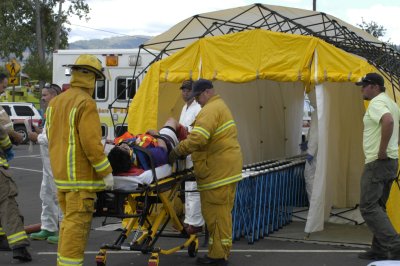
One of the event's organizers, Lake County Fire Protection District Battalion Chief Willie Sapeta said Sutter Lakeside Hospital, Redbud Community Hospital, Ukiah Valley Medical Center and Howard Memorial Hospital in Willits each would receive a set of victims – five major, five minor and five delayed – while the simulated casualties would be taken to mortuaries.
Helicopters began landing shortly before 4:15 p.m., led by a REACH air ambulance and a Cal Fire helicopter, with a CHP helicopter landing about 15 minutes later.
State Office of Emergency Services officials also were a part of the afternoon event.
George Lowry, assistant chief of communications, and Memoree McIntire, an emergency services coordinator whose area of responsibility includes Lake County, were at the scene.
Lowry said he offered technical support to the participants on communications issues.
McIntire acted as one of several evaluators who monitored the agencies' coordinated performance, including how the command post was set up and how the line of communication from the incident commanders to all of their personnel worked.
Overall, the group did well, she said.
"They know where some of their downfalls were but, overall, they were really good," she said.
McIntire said counties don't have to have the exercises annually, but should have them every few years.
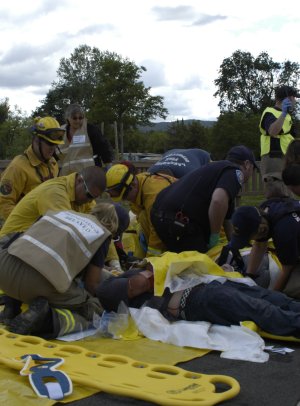
Lowry said the Homeland Security Exercise Evaluation Program gives grant funding for events such as the one on Wednesday. Prior to Homeland Security, the Federal Emergency Management Agency also had preparedness programs, he said.
Sapeta said the exercise was the culmination of seven months of planning, and cost about $15,000, which was paid for by the Homeland Security grant funds.
Officials were due to have a "hot wash" meeting after the exercise, which McIntire explained was a time to talk about how everything worked. From there, they'll create an action plan to address areas that need improvement.
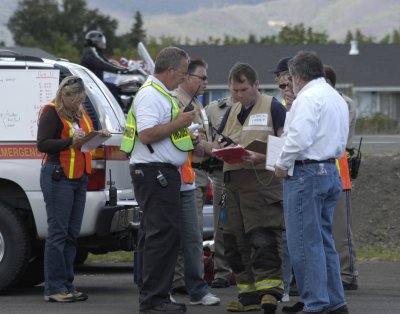
Garcia said the last multi-agency exercise was held last summer at Konocti Conservation Camp. That event's scenario concerned a simulated crash involving a busload of school children.
Since that last exercise, the fire districts have a whole different group of first responders due to high turnover, said Sapeta. Getting those new personnel a chance to practice together is important.
"We'll focus on next year's training based on what our deficits were," he said.
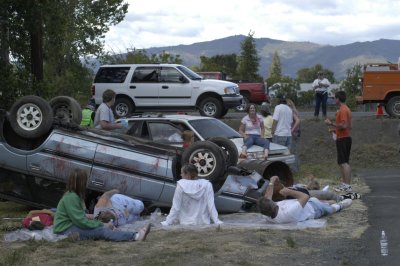
Northshore Fire Chief Jim Robbins said that the last time a large, multi-agency response was necessary for a disaster event locally was in 1996, when the Fork Fire raged across parts of the Northshore.
E-mail Elizabeth Larson at This email address is being protected from spambots. You need JavaScript enabled to view it..
{mos_sb_discuss:2}